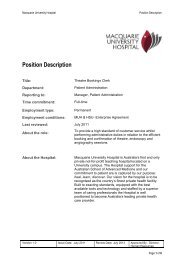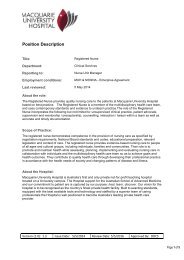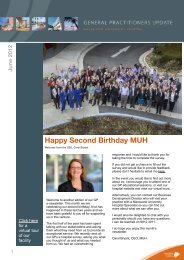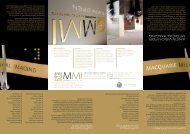Plenary Oral Presentations - Macquarie University Hospital
Plenary Oral Presentations - Macquarie University Hospital
Plenary Oral Presentations - Macquarie University Hospital
You also want an ePaper? Increase the reach of your titles
YUMPU automatically turns print PDFs into web optimized ePapers that Google loves.
16 th International Meeting of the Leksell Gamma Knife ® SocietyMarch 2012, Sydney, AustraliaVA-266Gamma knife radiosurgery for dural arteriovenous fistulas:A meta-analysis of treatment strategy and results in fourdifferent Gamma knife centers1Huai Che Yang, 1 David Hung Chi Pan, 2 Wan Yuo Guo1Department of Neurosurgery, Taipei Veterans General <strong>Hospital</strong>2Department of Neuroradiology, Taipei Veterans General <strong>Hospital</strong>Objective: Treatment options for dural arteriovenous fistulas (DAVFs) have expanded with theapplication of Gamma knife radiosurgery (GKS). To assess the role of GKS in treatment of DAVFs,we reviewed our entire DAVF experience and compared with three recent published DAVFs GKStreatment series from different centers.Methods: Between 1993 and 2010, 368 DAVFs underwent GKS in our hospital. In our series, 216patients were Cavernous-carotid fistulas, 97 patients were transverse-sigmoid fistulas and 55 patientshad DAVF in other location. 327 patients (89%) had only Gamma knife treatment and other 41patients (11%) had combined treatment with embolization or surgery. Seventy-five patients (20%)were diagnosed after sustaining an intracranial hemorrhage. We found more than 95% of patientshad neurological symptom improvement during follow-up. Seventy percent of 216 patients withcavernous-carotid fistulas and 59% of patients with non cavernous-carotid fistulas had obliterationconfirmed by imaging.We selected three recent published GKS series from <strong>University</strong> of Pittsburgh, <strong>University</strong> of Virginia,and Karolinska <strong>University</strong> hospital (series at least had 40 patients with more than 3 years follow-uppublished in recent 5 years) for comparison. We compared patients’ selection, treatment strategy, doseplan, treatment results and complication of four different series and try to find out the commonconclusion in current GKS treatment for DAVFs.Conclusions: GKS is a safe and effective treatment modality for intracranial DAVFs. For lowrisk DAVFs with benign clinical presentation, GKS can serve as a primary treatment. Symptomimprovement rate and image proved obliteration rate can be achieved in more than 70% to 90%within 2 years with little adverse events. For high risk DAVFs with extensive retrograde corticalvenous drainage, hemorrhage or severe venous hypertension, treatment combined with embolizationor surgery is suggested.81
















